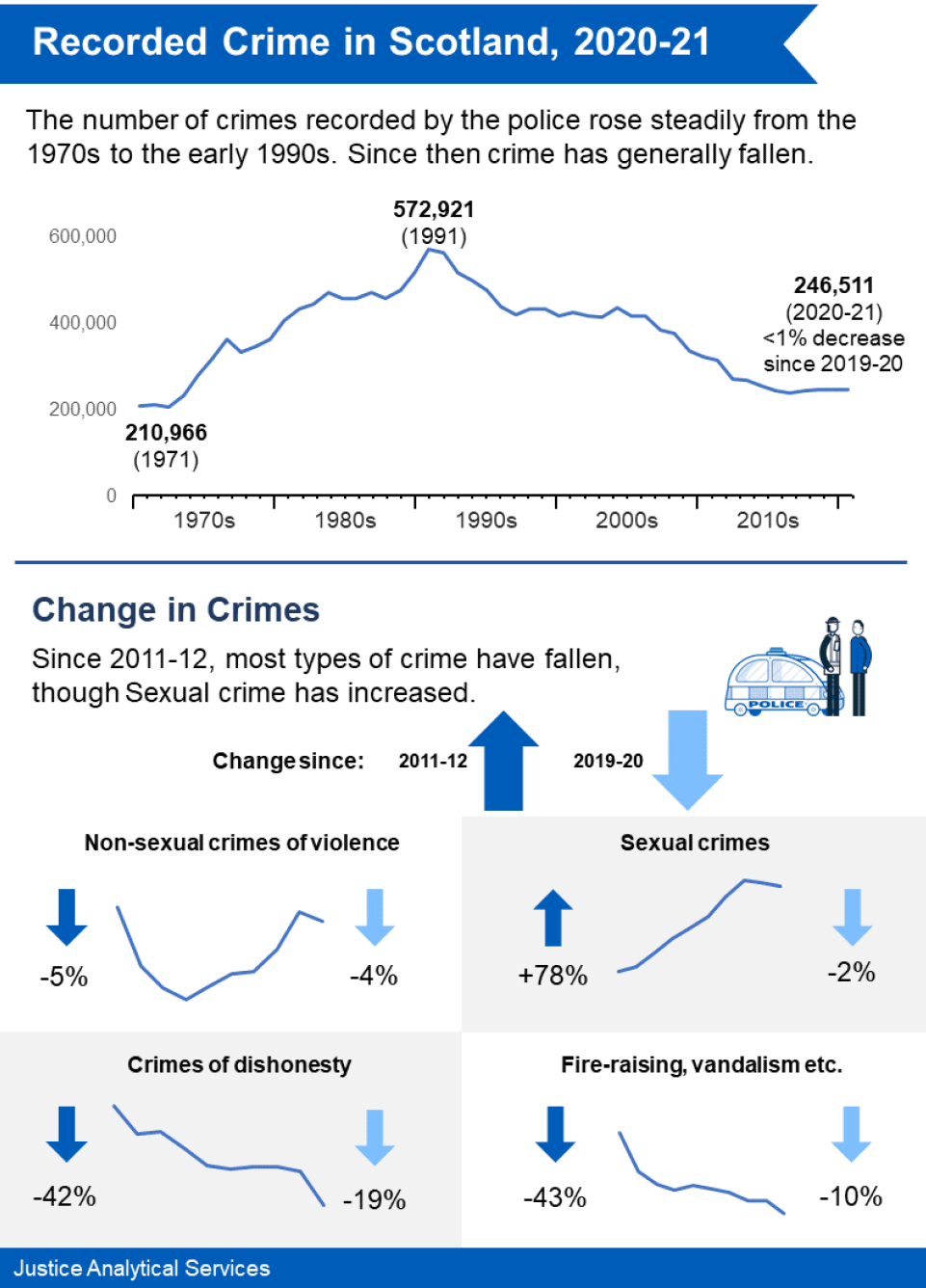Recorded Crime in Scotland, 2020-2021
Statistics on crimes and offences recorded and cleared up by the police in Scotland, split by crime or offence group and by local authority. This bulletin also includes a new chapter which presents an estimate of how many cyber-crimes were recorded in Scotland during 2019-20 and 2020-21.
This document is part of a collection
Recorded Crime in Scotland, 2020-21
This bulletin presents National Statistics on crimes and offences recorded by the police in 2020-21. Statistics on crimes and offences recorded by the police provide a measure of the volume of criminal activity with which the police are faced. Crimes recorded by the police do not reveal the incidence of all crime committed since not all crimes are reported to the police. For a definition of crimes recorded, refer to Annex 1.
The nationwide lockdowns and other measures put in place to limit social contact during the Coronavirus (COVID-19) pandemic are very likely to have had a significant impact on the type and volume of crime recorded in the 2020-21 figures. However, some caution is advised before necessarily attributing all of the changes to this situation. For example, longer term trends in some types of offending, which existed prior to the pandemic, may remain a factor.
Key Points from Recorded Crime in Scotland
Between 2019-20 and 2020-21, crimes recorded by the police in Scotland remained almost unchanged, decreasing by just 5 crimes from 246,516 to 246,511. The 2020-21 figures include 20,976 crimes recorded under Coronavirus related legislation, compared to just 107 towards the end of 2019-20. All other crimes collectively decreased by 8%. The recording of crime remains at one of the lowest levels seen since 1974.
Other changes between 2019-20 and 2020-21:
- Non-sexual crimes of violence decreased by 4%, from 9,316 to 8,972. This includes the recording of 1,641 crimes under the Domestic Abuse (Scotland) Act 2018 in 2020-21, the second year this legislation has been in place.
- Sexual crimes decreased by 2% from 13,364 to 13,131. Whilst this follows a decrease in 2019-20, these crimes remain at the third highest level seen since 1971, the first year for which comparable groups are available.
- Crimes of dishonesty decreased by 19%, from 111,409 to 89,731. The recording of these crimes is at the lowest level seen since 1971.
- Fire-raising, vandalism etc. decreased by 10% from 47,731 to 42,964. The recording of these crimes is at the lowest level seen since 1975.
- Other crimes increased by 10% from 64,589 to 70,737. Most of these crimes relate to drug possession, crimes against public justice or handling offensive weapons.
Offences recorded by the police in Scotland decreased by 4% from 250,662 to 240,174.
- Miscellaneous offences decreased by 4%, from 128,755 to 124,120.
- Motor vehicle offences decreased by 5% from 121,907 to 116,054.
Police recorded cyber-crime in Scotland
This bulletin also includes a new chapter which presents an estimate of how many cyber-crimes were recorded in Scotland during 2019-20 and 2020-21.
Key points:
- In 2020-21, an estimated 14,130 cyber-crimes were recorded by the police in Scotland. This has almost doubled (increasing by 95%) compared to the estimated 7,240 cyber-crimes recorded in 2019-20.
- Part of this increase may be due to the significant impact of the Coronavirus (COVID-19) pandemic, including behavioural changes such as increased online shopping.
- Cyber-crimes accounted for an estimated one-in-three sexual crimes (33%) in 2020-21, and around one-in-ten of both Non-sexual crimes of violence and Crimes of dishonesty (12% and 10% respectively).
- A procedural change was made to the recording of international crime in 2020-21, whereby cases carried out by a perpetrator who was likely to be outside the UK are now included. This change resulted in an estimated 1,160 additional crimes being recorded, which represents less than 1% of all crime recorded this year.
Official Statistics on Clear up rates
In addition to the National Statistics on police recorded crimes and offences, this bulletin also presents Official Statistics on crimes and offences cleared up by the police in 2020-21.
Clear up rates measure the percentage of recorded crimes that have been cleared up. For further information on the statistical designation of this data and a definition of clear up rates, please refer to Chapter 4. Crimes recorded under Coronavirus related legislation are excluded from these statistics, as a bespoke and separate data collection is used by police to capture these cases.
The clear up rate in 2020-21 was 56.3%, the highest since comparable records began in 1976, and up 4.8 percentage points from 51.5% in 2019-20.
This increase is the largest one year change on record, and likely reflects the impact of the Coronavirus (COVID-19) pandemic on the types of crime recorded. The number of Crimes of dishonesty and Fire-raising, vandalism etc., which have relatively lower clear up rates, fell much more in 2020-21 than Non-sexual crimes of violence and Sexual Crimes, which have relatively higher clear up rates. Further to this, the volume of Other Crimes recorded in 2020-21 (which traditionally have the highest clear up rates) increased by 10%.

Contact
Email: Justice_Analysts@gov.scot
There is a problem
Thanks for your feedback